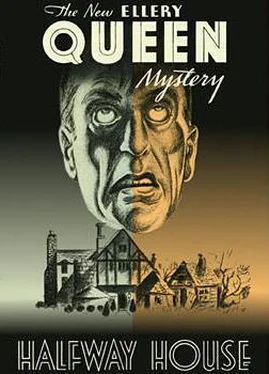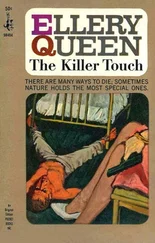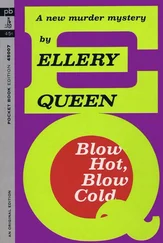“Sit down, Bill,” said Ellery. “Apparently we’ve run into something.” Bill obeyed. His eyes had become watchful again.
“Well?” drawled De Jong in a half-amused way.
Ellery took out his pipe. “I’m at a disadvantage. Obviously you men have information of which I’m ignorant. At the moment, I can offer no theory which focuses upon an individual. The facts don’t lend themselves to solution, at least the facts at my disposal. But, from the instant I identified Wilson as Gimball, it struck me that there was one line of investigation which might prove fruitful. I suppose you gentlemen have seen your local papers recently?”
Pollinger pulled a long face. “They’ve had a field day of it.”
“There was one story by a fellow-townswoman of yours,” continued Ellery, “which I confess impressed me. I refer to the work of that charming young hoyden with the red hair who writes special features for the Trenton Times. ”
“Ella Amity’s all right,” said De Jong indifferently.
“Oh, wake up, De Jong. That’s faint praise. The woman’s grasped something which has escaped all of you. Do you recall her sobriquet for the shack in which Gimball met his death?” The two officials looked politely blank. Bill was sucking a knuckle with absorption. “She named it,” observed Ellery, “Halfway House.”
“Halfway House.” Pollinger looked impatient. “Oh, yes.”
“It doesn’t strike sparks,” said Ellery dryly. “But it should. She put her canny finger on the very heart of the problem.”
De Jong sneered. “It sounds plain screwy to me.”
“Your loss. The phrase is a positive inspiration. Don’t you see its significance?” He exhaled a cloud of smoke. “Tell me. Whose murder are you investigating?”
“Whose—” The prosecutor sat up sharply.
“It’s a riddle,” grinned De Jong. “I’ll bite. Mickey Mouse?”
“Not bad, De Jong,” said Ellery. “I ask once more: Who has been murdered?” He waved his long fingers. “And if you can’t give him a name, it’s going to be more difficult to find his killer.”
“What are you driving at?” snapped Pollinger. “Joseph Kent Gimball, of course. Or Joseph Wilson, or Henry Smith, or any other damned name you want to call him by. We’ve got the man, the body; that’s the important thing; and we know who he is. What difference does his name make?”
“Possibly all the difference in the world. Old Shakespeare unfortunately didn’t live in the days of criminological science. You see, you don’t know. Gimball or Wilson — precisely. This man was Wilson in Philadelphia and Gimball in New York. He was polished off in Trenton... Halfway House, says our Ella. Very apt indeed. Now in Halfway House, to push the conceit a little further,” continued Ellery soberly, “you found Gimball clothes and Wilson clothes, a Gimball car and a Wilson car. In Halfway House this man was both Gimball and Wilson, you see. And so I ask again: In what personality was the man murdered? As Gimball or as Wilson? Whom did the murderess think she was dispatching — Joseph Kent Gimball of New York or Joe Wilson of Philadelphia?”
“I never thought of it in that way,” muttered Bill. Pollinger rose and began to patrol the floor behind his desk.
De Jong jeered. “Nuts and double-nuts. Hifalutin’ stuff.”
Pollinger halted. He shot a peculiar look at Ellery from under his sparse brows. “And in what personality do you think he was killed?”
“That,” sighed Ellery, “is indeed the question. I can’t answer it. Can you?”
“No.” Pollinger sat down. “No, I can’t. But it seems to me to be still a purely academic question. I can’t see how... Look here.”
“Here it comes,” said Bill. His hands hung loosely between his knees, perfectly controlled. Ellery smoked calmly.
The prosecutor’s slender fingers played with a paper-cutter on his desk. “De Jong’s made a major discovery. He’s found the car used by the person who murdered Gimball Saturday night — the small car with the Firestone tires.”
Ellery glanced at Bill. It was odd how Pollinger’s simple statement affected the young man. It tightened his skin like a caustic, making it look dry and old. He sat in a lump as if he were afraid the slightest movement would precipitate an avalanche. “Well?” He cleared his throat. “Well?”
Pollinger shrugged. “Abandoned. Had an accident.”
“Where?” demanded Ellery.
“And don’t think,” drawled De Jong, “there’s any doubt about it, gents. It’s the bus, all right.”
“An Olympian utterance. How can you be certain?”
Pollinger opened the top drawer of his desk. “By reason of three quite conclusive facts.” He tossed over a bundle of photographs. “The impressions of the tires. We’ve made casts of the middle set of marks from the mud in front of the shack, and compared them with the tires of the car we found — ’32 Ford, by the way, coupé, black paint job. Well, casts and tires coincide. That’s number one.”
Bill was blinking as if the green-shaded light hurt his eyes. “And number two?”
“Number two,” replied the prosecutor, putting his hand into the drawer again, “is this.” He brought out the rusty figurine of the naked woman which De Jong’s man had found in the main driveway on the night of the murder — the radiator-cap which had snapped off at the ankles of the figure. And then he placed beside it another object made of the same rust-flecked metal — the plug of the cap, with two jagged ends of metal sticking up from its top. “Examine them. You’ll find that the broken edges of the metal ankles fit exactly into the broken ends of the metal feet on the cap.”
“The cap comes from this Ford coupé?” asked Ellery intently.
“If it doesn’t,” said De Jong, “I was dreaming when I unscrewed it.”
“Of course,” continued Pollinger in an odd tone, “this is almost as sound evidence as a fingerprint. Now, number three.” For the fourth time his hand went to the drawer; when it emerged, it was swathed in some dark filmy material.
“The veil!” exclaimed Ellery; he reached for it. “Where did you find this, by thunder?”
“On the driver’s seat of the coupé.” Pollinger leaned back. “You can see how important this veil is as evidence. The tire marks and the broken radiator-cap establish the Ford as having visited the scene of the crime on Saturday evening. The veil serves to fix guilt. Found in the Ford, it sets up a reasonable presumption that the Ford was driven by the criminal. For the victim himself told Angell with his dying breath that his murderess wore a veil. And veils aren’t common these days.”
Bill was glaring at the veil. “As a lawyer,” he said hoarsely, “of course you realize that’s the frailest kind of circumstantial evidence? You haven’t connected. Where’s your eye-witness? That would be a case. Or have you checked the times involved? How do you know the car wasn’t abandoned long before the crime-period? How—”
Pollinger said slowly: “My dear young man, I know the law very well indeed.” He rose and began pacing again.
There was a knock on the door, and the thin little man whirled about. “Come in!”
Sellers, the small brown man attached to De Jong’s staff, opened the door; there was another detective behind him. The brown man seemed a little surprised at the sight of the two visitors. “Well?” barked De Jong. “Everything go off all right?”
“Fine.”
De Jong flashed a glance at Pollinger. The prosecutor nodded and turned away. Bill was gripping the arms of his chair, looking wildly from face to face. Sellers mumbled something and the other man vanished. A moment later he reappeared with his hand on the arm of Lucy Wilson. All the blood seemed permanently to have deserted her skin. There were large violet arcs under her splendid eyes. Her hands were fists and her high breasts rose and fell in surges. There was something so bedraggled and woebegone in her appearance that for a long moment no one seemed able to find his tongue. Then she said, in a weak voice: “Bill. Oh, Bill darling,” and she stumbled toward him.
Читать дальше












